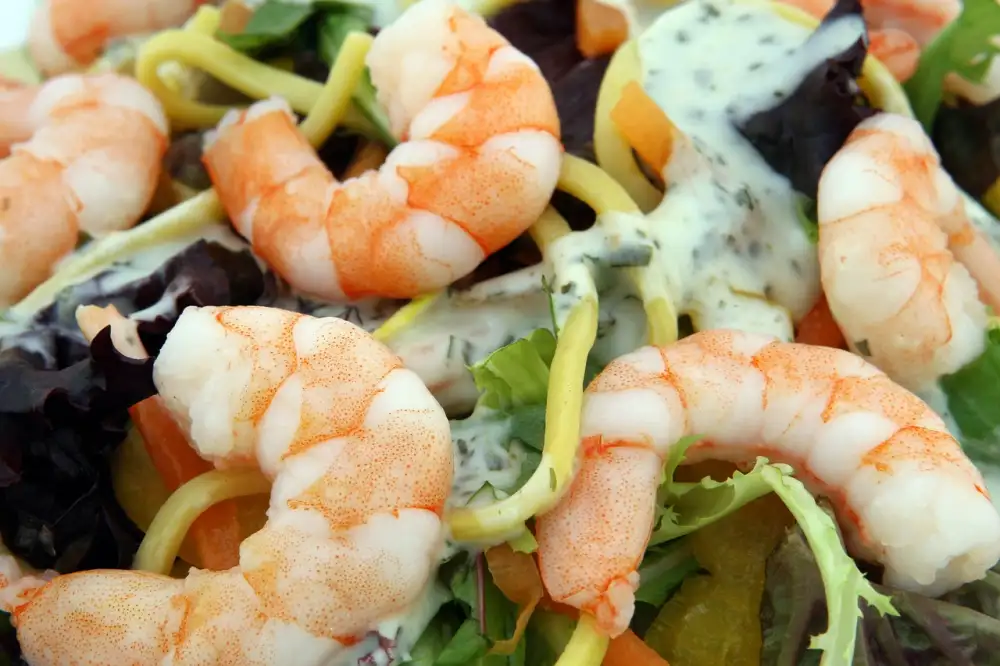Prawns vs Shrimp: Unraveling the Distinctive Delights of Crustacean Cuisine

- Appearance: Examining the Physical Characteristics of Prawns and Shrimp
- Habitat: Exploring the Different Environments Where Prawns and Shrimp Thrive
- Taste and Texture: Comparing the Flavor Profiles and Culinary Uses of Prawns and Shrimp
- Size Matters: Highlighting the Varied Sizes of Prawns and Shrimp
- Availability: Discussing the Global Distribution and Accessibility of Prawns and Shrimp
- Cooking Techniques: Discovering the Best Ways to Prepare Prawns and Shrimp in Dishes
- Nutritional Value: Evaluating the Health Benefits and Nutrient Content of Prawns and Shrimp
- Price and Market Demand: Analyzing the Economic Factors Influencing Prawn and Shrimp Prices
When it comes to crustacean cuisine, the terms "prawns" and "shrimp" are often used interchangeably. However, these two delicacies have distinct characteristics that set them apart. From their appearance and habitat to their taste and texture, prawns and shrimp offer unique culinary experiences. In this article, we will unravel the differences between these delectable creatures, exploring their physical attributes, habitats, flavors, sizes, availability, cooking techniques, nutritional value, market demand, and more. Join us on a journey to discover the distinctive delights of prawns and shrimp!
Appearance: Examining the Physical Characteristics of Prawns and Shrimp
When it comes to appearance, prawns and shrimp may seem similar at first glance, but upon closer inspection, there are distinct physical characteristics that set them apart. Prawns typically have a longer body with a slight curve, while shrimp have a more compact body shape. Prawns also tend to have larger claws compared to shrimp. Additionally, prawns often have a reddish-brown coloration, whereas shrimp can range from gray to greenish-brown. These subtle differences in appearance contribute to the unique visual appeal of both crustaceans in culinary presentations.
Habitat: Exploring the Different Environments Where Prawns and Shrimp Thrive
Prawns and shrimp may seem similar, but their habitats tell a different story. Prawns are typically found in freshwater environments such as rivers, lakes, and ponds. They prefer calm waters with muddy or sandy bottoms. Shrimp, on the other hand, thrive in saltwater habitats like oceans and seas. They can be found in both shallow coastal areas and deeper offshore waters. It is fascinating how these crustaceans have adapted to different environments, showcasing their remarkable versatility in nature.
Taste and Texture: Comparing the Flavor Profiles and Culinary Uses of Prawns and Shrimp
When it comes to taste and texture, prawns and shrimp offer distinct culinary experiences. Prawns are known for their sweeter and more delicate flavor, often described as buttery or slightly nutty. They have a firm and meaty texture that holds up well in various cooking methods, making them perfect for grilling, sautéing, or stir-frying.
On the other hand, shrimp have a slightly briny and more pronounced seafood flavor. They are also tender and juicy with a softer texture compared to prawns. Shrimp are versatile in the kitchen and can be used in a wide range of dishes such as pasta, salads, curries, or even as an appetizer.
Both prawns and shrimp lend themselves well to absorbing flavors from marinades, sauces, or spices. They can be seasoned with herbs like garlic, parsley, or cilantro to enhance their natural taste. Whether you prefer the subtle sweetness of prawns or the bolder flavor of shrimp, these crustaceans offer endless possibilities for creating delicious meals.
Size Matters: Highlighting the Varied Sizes of Prawns and Shrimp
When it comes to size, prawns and shrimp exhibit a wide range of variations. Prawns are generally larger than shrimp, with some species growing up to 12 inches in length. On the other hand, shrimp tend to be smaller, typically measuring around 2-6 inches long. However, it's important to note that these sizes can vary depending on the specific species and geographical location. Regardless of their size, both prawns and shrimp offer unique culinary possibilities due to their distinctive flavors and textures.
Availability: Discussing the Global Distribution and Accessibility of Prawns and Shrimp
Prawns and shrimp are widely available in various parts of the world, making them a popular choice for seafood lovers. They can be found in both freshwater and saltwater environments, allowing for a diverse range of options when it comes to sourcing these crustaceans. Prawns are commonly found in Asia, particularly in countries like India, China, and Thailand. Shrimp, on the other hand, are more prevalent in the Americas, with countries like the United States, Mexico, and Ecuador being major producers. Both prawns and shrimp can also be sourced from Africa and Europe. Thanks to advancements in transportation and global trade networks, these delicacies have become accessible to consumers worldwide. Whether you're dining at a high-end seafood restaurant or shopping at your local grocery store, chances are you'll find an abundance of prawns and shrimp to choose from. So no matter where you are in the world, indulging in the distinctive delights of prawns and shrimp is just a few steps away!
Cooking Techniques: Discovering the Best Ways to Prepare Prawns and Shrimp in Dishes
When it comes to cooking techniques, both prawns and shrimp offer a world of possibilities. These crustaceans can be grilled, sautéed, boiled, or even deep-fried to create mouthwatering dishes. Grilling brings out the natural sweetness of prawns and shrimp, while sautéing allows for a quick and flavorful preparation. Boiling is ideal for dishes like soups and stews, as it helps to infuse the flavors into the broth. Deep-frying creates a crispy exterior that complements the tender meat inside. Whether you're making a classic shrimp scampi or a spicy prawn curry, these versatile ingredients lend themselves well to various cooking techniques, making them a favorite among chefs and home cooks alike.
Nutritional Value: Evaluating the Health Benefits and Nutrient Content of Prawns and Shrimp
Prawns and shrimp are not only delicious, but they also offer numerous health benefits. Both crustaceans are low in calories and fat, making them an excellent choice for those watching their weight. They are also rich in protein, which is essential for building and repairing tissues in the body. Additionally, prawns and shrimp contain omega-3 fatty acids, known for their heart-healthy properties. These fatty acids help reduce inflammation and lower the risk of heart disease. Furthermore, prawns and shrimp are a good source of vitamins and minerals such as vitamin B12, selenium, and zinc. These nutrients play a vital role in maintaining a healthy immune system and supporting brain function. Overall, incorporating prawns and shrimp into your diet can provide you with a delicious way to boost your nutritional intake.
Price and Market Demand: Analyzing the Economic Factors Influencing Prawn and Shrimp Prices
When it comes to the price of prawns and shrimp, several economic factors come into play. One of the key factors is market demand. Both prawns and shrimp are highly sought after in many cuisines around the world, leading to a strong demand for these crustaceans. This high demand can drive up prices, especially for larger and more desirable species.
Another factor that influences prices is the availability of prawns and shrimp. If there is a shortage in supply due to environmental factors such as overfishing or natural disasters, prices can increase significantly. Conversely, when there is an abundance of prawns and shrimp, prices tend to be more affordable.
Additionally, transportation costs play a role in determining prices. Prawns and shrimp are often transported from their source to various markets around the world. The cost of transportation, including fuel prices and logistics, can impact the final price consumers pay for these delicacies.
Lastly, global economic conditions can also influence the price of prawns and shrimp. Fluctuations in currency exchange rates or changes in trade policies between countries can affect import and export costs, ultimately impacting the price consumers pay at their local markets.
Overall, the price of prawns and shrimp is influenced by market demand, availability, transportation costs, and global economic conditions. Understanding these economic factors can help consumers make informed choices when purchasing these delectable crustaceans.
In conclusion, while prawns and shrimp are often used interchangeably, there are distinct differences between the two. Prawns tend to be larger in size and have a sweeter, more robust flavor. Shrimp, on the other hand, are smaller and have a slightly milder taste. Both crustaceans offer a wide range of culinary possibilities, from grilling and frying to steaming and stir-frying. Their versatility makes them popular ingredients in various cuisines around the world. Whether you prefer the delicate texture of shrimp or the meatier bite of prawns, these crustaceans are sure to delight your taste buds with their unique flavors and textures.
Published: 26. 11. 2023
Category: Food



